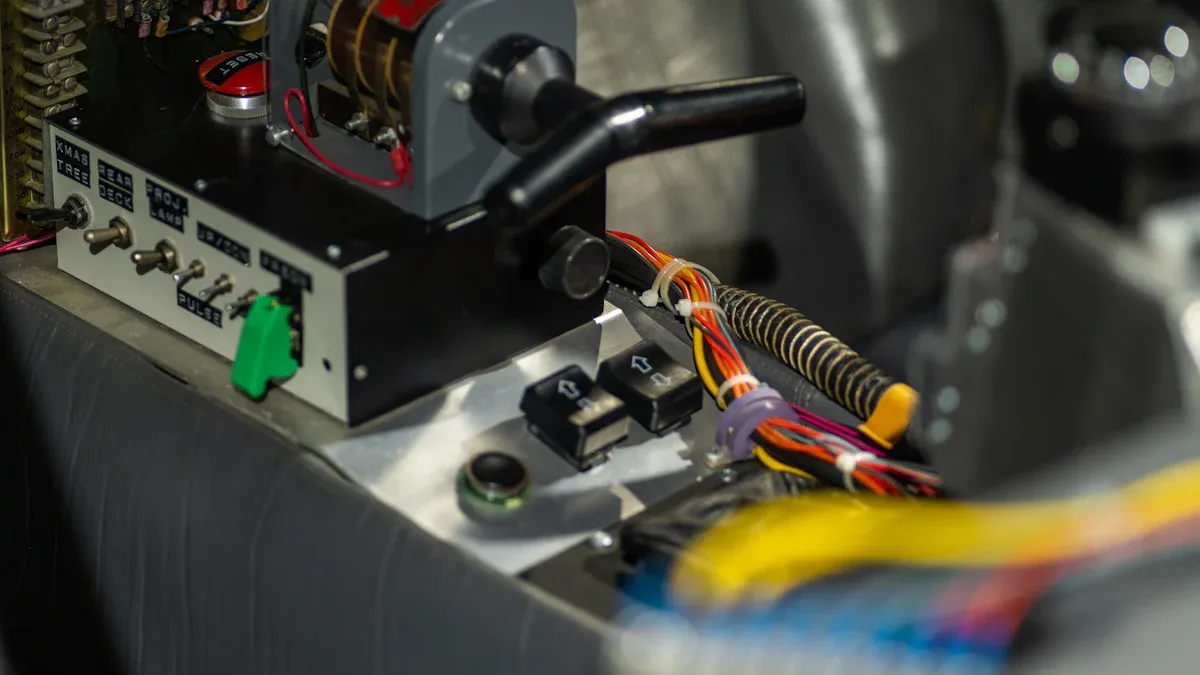What Is the AD8221ARZ Instrumentation Amplifier and Its Key Features

You can rely on the AD8221ARZ as a precision instrumentation amplifier from Analog Devices. This device gives you accurate, low-noise signal amplification and stands out with its high common-mode rejection ratio (CMRR). When you need reliable performance in measurement or signal conditioning, the AD8221ARZ offers several unique features:
Very low voltage offset and drift for excellent DC accuracy
High gain accuracy with programmable gain from 1 to 1000, set by just one resistor
Maintains at least 80 dB CMRR up to 10 kHz, far above typical amplifiers
Operates on single or dual supplies, from ±2.3 V to ±18 V
Compact package options for tight spaces
These qualities make it a strong choice for demanding precision applications.
Key Takeaways
The AD8221ARZ amplifier delivers very accurate and low-noise signal amplification, making it ideal for precise measurements.
It offers a high common-mode rejection ratio (CMRR) that blocks unwanted noise even at high frequencies, ensuring clean signals.
You can easily set the gain from 1 to 1000 using just one resistor, allowing flexible use with different sensors and signals.
The amplifier works with a wide range of power supplies and has a compact size, fitting well in many devices and systems.
Its features make it perfect for medical, industrial, and data acquisition applications where accuracy and reliability matter most.
AD8221ARZ Overview

Function
You can use the AD8221ARZ when you need to amplify small signals in the presence of large unwanted voltages. This device comes from Analog Devices and works as a high-performance, gain-programmable instrumentation amplifier. You will find it helpful in many precision measurement systems. Here is what the AD8221ARZ does for you:
Amplifies low-level differential signals, even when high common-mode voltages are present.
Delivers an industry-leading common-mode rejection ratio (CMRR) of at least 80 dB up to 10 kHz. This helps you reject wideband interference and line harmonics.
Offers low offset voltage and low offset drift, which means you get stable and accurate readings over time.
Lets you set the gain from 1 to 1000 with just one external resistor, making it flexible for different applications.
Supports both single and dual power supplies, so you can use it in many types of circuits.
Handles input voltages up to ±10 V, which gives you more options for signal sources.
You can rely on the AD8221ARZ for tasks like data acquisition, biomedical analysis, aerospace instrumentation, and bridge signal conditioning. These features help you keep your signals clean and accurate, even in tough environments.
Performance
The AD8221ARZ gives you strong performance for demanding applications. You get fast response and low input bias current, which helps you measure signals without adding much error. Here is a quick look at some important performance metrics:
Parameter | Value |
|---|---|
2 V/µs | |
-3 dB Bandwidth | 825 kHz |
Input Bias Current | 500 pA |
Supply Voltage Range | 4.6 V to 36 V |
You can see that the AD8221ARZ works well with a wide range of supply voltages. The high bandwidth and fast slew rate let you capture quick changes in your signals. The low input bias current means you do not have to worry about the amplifier affecting your measurements. These qualities make the AD8221ARZ a top choice for precision signal amplification.
Key Features
High CMRR
You need strong noise rejection in precision circuits. The AD8221ARZ gives you a high common-mode rejection ratio (CMRR) across a wide frequency range. This means it can block unwanted signals that appear on both input lines, even at higher frequencies.
The CMRR stays at a minimum of 80 dB from DC up to 10 kHz (gain = 1).
At low frequencies, the CMRR can reach about 89.3 dB.
Many other amplifiers lose CMRR above 200 Hz, but this device keeps its performance steady.
You can trust it to reject common-mode noise in environments with lots of electrical interference.
Tip: High CMRR helps you get clean, accurate measurements, even when your signals are small and noise is everywhere.
Low Offset Voltage
You want your amplifier to add as little error as possible. The AD8221ARZ has a very low input offset voltage, which means the voltage difference between its inputs is almost zero when no signal is present. This keeps your measurements accurate.
Parameter | Typical Value | Maximum Value | Conditions |
|---|---|---|---|
Input Offset Voltage | 25 µV (BR) | ±15 V supply, 25°C, Gain=1 | |
Offset Voltage Drift | N/A | 0.3 µV/°C | -40°C to +85°C |
You get stable readings over time and temperature.
This feature is important for applications where you measure tiny signals.
Low offset voltage means you can trust your results, especially in sensitive medical or scientific equipment.
Programmable Gain
You often need to adjust how much your amplifier boosts a signal. The AD8221ARZ lets you set the gain from 1 to 1000 using just one external resistor. This makes it easy to match the amplifier to your needs.
Parameter | AD8221ARZ |
|---|---|
Gain Range | 1 to 1000 |
Gain Setting | Single resistor |
Gain Bandwidth Product | 825 kHz |
You can quickly change the gain for different sensors or signals.
High gain accuracy and stability help you get reliable results.
The simple gain adjustment saves you time and space in your design.
With programmable gain, you can use the same amplifier for many different tasks.
Low Noise
You want your amplifier to add as little noise as possible. The AD8221ARZ has a low input voltage noise of 8 nV/√Hz at 1 kHz. This low noise level helps you keep your signals clear.
Low noise improves the signal-to-noise ratio.
You can detect smaller signals without interference.
This is important for medical devices, scientific tools, and other sensitive equipment.
Low noise means your measurements stay sharp and accurate, even when signals are weak.
Wide Supply Range
You may need your amplifier to work with different power supplies. The AD8221ARZ supports a wide supply voltage range, making it flexible for many designs.
Parameter | Value |
|---|---|
Supply Voltage Range | |
Dual Supply Voltage | ±18 V |
You can use it with single or dual supplies.
It works well in systems with different voltage needs.
The amplifier keeps working reliably across a wide temperature range.
A wide supply range lets you use the AD8221ARZ in many types of equipment, from portable devices to industrial machines.
High Input Impedance
You need high input impedance to avoid loading your signal source. The AD8221ARZ offers this feature, so it does not draw much current from your sensors.
High input impedance means less signal loss.
Low input bias current (about 1.2 nA) supports accurate measurements.
This feature is important for medical, industrial, and scientific applications.
High input impedance helps you measure signals without changing them, which is key for precision work.
In summary:
The AD8221ARZ combines high CMRR, low offset voltage, programmable gain, low noise, wide supply range, and high input impedance. These features help you build precise, reliable, and compact measurement systems. You can use this amplifier in many demanding applications and trust it to deliver accurate results.
Applications

Medical
You often find precision amplifiers in medical equipment. These devices help you measure very small signals from the human body. For example, you might use them in ECG machines to detect heart activity or in EEG systems to monitor brain waves. High accuracy and low noise are important in these tools because even a tiny error can affect a diagnosis.
Medical equipment often uses amplifiers for:
ECG (electrocardiogram) monitoring
EEG (electroencephalogram) systems
Blood pressure sensors
Temperature measurement devices
In medical settings, you need amplifiers that deliver stable and accurate readings. This helps doctors and nurses trust the results.
Industrial
In factories and process control systems, you need to measure signals from many types of sensors. These sensors might include strain gauges, pressure sensors, or temperature probes. You want to amplify these signals without adding noise or errors.
Common uses in industrial settings:
Signal conditioning for sensors like strain gauges and transducers
Weigh scales and bridge amplifiers
Industrial process control systems
Automation equipment
You can rely on precision amplifiers to work in harsh environments. They operate over a wide temperature range and handle different supply voltages. Low input offset voltage and bias current help you get accurate measurements, even when conditions change.
Tip: High common-mode rejection ratio (CMRR) helps you block interference from motors and other machines.
Data Acquisition
When you collect data from sensors, you need to make sure the signals are clear and accurate. Data acquisition systems use amplifiers to boost weak signals before sending them to a computer or display.
Data acquisition systems benefit from:
High input impedance, which prevents signal loss
Low noise, which keeps your data clean
Programmable gain, which lets you adjust for different sensors
You might use these systems in test and measurement instruments, scientific research, or quality control labs. Accurate signal amplification helps you make better decisions based on your data.
Note: Reliable data acquisition starts with a strong, low-noise amplifier.
You gain reliable, accurate signal amplification when you choose this instrumentation amplifier. Its high CMRR, low noise density, and flexible gain make it ideal for precision work. Review the table below to see why it stands out:
Parameter | Value/Description |
|---|---|
CMRR | |
Noise Density | 8 nV/√Hz |
Offset Voltage | ±150 μV max |
Gain Range | 1 to 1000 |
Output Swing | Rail-to-rail |
For projects that demand accuracy and stability, this amplifier helps you achieve clean results with ease.
FAQ
What makes the AD8221ARZ different from other instrumentation amplifiers?
You get high CMRR over a wide frequency range, low offset voltage, and easy gain adjustment with one resistor. These features help you achieve accurate and stable signal amplification in many applications.
Can you use the AD8221ARZ with a single power supply?
Yes, you can use it with a single supply as low as 4.6 V. This flexibility lets you design circuits for both portable and industrial equipment.
How do you set the gain on the AD8221ARZ?
You set the gain by connecting one external resistor between the RG pins. The gain formula is:
Gain = 1 + (49.4 kΩ / RG)
Tip: Choose RG to match your desired gain.
Is the AD8221ARZ suitable for battery-powered devices?
Yes, you can use it in battery-powered devices. It has low power consumption and works with low supply voltages. This makes it a good choice for portable medical or measurement tools.
What package options does the AD8221ARZ offer?
You can choose from small packages like SOIC and MSOP. These compact options help you fit the amplifier into tight spaces on your circuit board.
See Also
Exploring Key Features Of Integrated Circuit Audio Processors
A Comprehensive Guide To Analog IC Design And Uses
Introduction To Isolation Amplifier ICs And Their Applications
Key Characteristics And Functions Of Temperature Sensor Chips
Overview Of Low-Power Operational Amplifier Integrated Circuits
